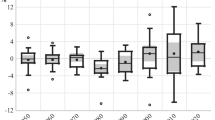Abstract
We demonstrate that a different causal relationship exists between the current and financial accounts in developed and developing countries. Using the Granger causality test, we clearly determine that the financial account is by and large responsible for the current account in developing countries; instead of financing the current account, the financial account thrusts the current account into an imbalance. In developed countries, however, the current account leads the way, and the financial account, as its name indicates, serves to finance a current account imbalance. This represents a forewarning that countries, which lack a sophisticated financial system to channel funds to proper locations, should not recklessly liberalize capital mobility.
Similar content being viewed by others
References
Bosworth, B.; Collins, S. “Capital Flows to Developing Economies: Implications for Saving and Investment,” Brookings Papers on Economic Activity, 1, 1999, pp. 143–80.
Cooper, R. “Is the U.S. Current Account Deficit Sustainable? Will it be Sustained?” Brookings Papers on Economic Activity, 1, 2001, pp. 217–26.
Corsetti, G.; Pesenti, P.; Roubini, N. “What Caused the Asian Currency and Financial Crisis?,” Japan and the World Economy , 11, 3, October 1999, pp. 305–73.
Dolado, J.; Lütkepohl, H. “Making Wald Tests Work for Cointegrated VAR Systems,” Econometrics Review, 15, 1996, pp. 369–86.
Edison, H.; Klein, M.; Ricci, L.; Slok, T. “Capital Account Liberalization and Economic Performance: Survey and Synthesis,” IMF Working Paper, WP/02/120, 2002.
Edwards, S. “Does the Current Account Matter?,” in Preventing Currency Crises in Emerging Markets, Sebastian Edwards and Jeffrey A. Frankel, (eds.), The University of Chicago Press, 2002.
Elliot, G.; Rothenberg, T. J.; Stock, J. H. “Efficient Tests for an Autoregressive Unit Root,” Econometrica, 64, 1996, pp. 813–36.
Enders, W. Applied Econometric Time Series, John Wiley & Sons, Inc., 1995.
Engle, R; Granger, C. “Cointegration and Error Correction Representation, Estimation and Testing,” Econometrica, 55, 1987, pp. 251–76.
Johansen, S. “Estimation and Hypothesis Testing of Cointegration Vectors in Gaussian Vector Autoregressive Models,” Econometrica, 59, 1991, pp. 1551–80.
Johansen, S. Likelihood-based Inference in Cointegrated Vector Autoregressive Models, Oxford University Press, 1995.
Kaminsky, G. L.; Schmukler, S. L. “Short-run Pain, Long-run Gain: The Effects of Financial Liberalization,” IMF Working Paper, WP/03/34, 2003.
Kwiatkowski, D.; Phillips, P. C. B.; Schmidt, P.; Shin, Y. “Testing the Null of Stationarity against the Alternative of a Unit Root: How Sure Are We that Economic Time Series Have a Unit Root?,” Journal of Econometrics, 54, 1992, pp. 159–78.
Newey, W.; West, K. “Automatic Lag Selection in Covariance Matrix Estimation,” Review of Economic Studies, 61, 1994, pp. 631–53.
Ng, S.; Perron, P. “Lag Length Selection and the Construction of Unit Root Tests with Good Size and Power,” Econometrica, 69, 6, 2001, pp. 1919–54.
Obstfeld, M.; Rogoff, K. Foundations of International Macroeconomics, The MIT Press, 1996.
Pakko, M. “The United States Trade Deficit and the ‘New Economy’,” Federal Reserve Bank of the St. Louis Review, 81, 5, September/October 1999, pp. 11–20.
Poole, W. “Does the United States Have a Current Account Deficit Disorder?,” Remarks Before the Business and Community Leaders’ Luncheon, the Lannom Center, Federal Reserve Bank of St. Louis, 2001.
Summers, L. “International Financial Crises: Causes, Prevention, and Cures,” American Economic Review, 90, 2, 2000, pp. 1–16.
Toda, H. Y.; Yamamoto, T. “Statistical Inference in Vector Autoregressions with Possibly Integrated Processes,” Journal of Econometrics, 66, 1995, pp. 225–50.
Wong, C.-H.; Carranza, L. “Policy Responses to External Imbalances in Emerging Market Economies: Further Empirical Results,” IMF Staff Papers, 46 (2), 1999, pp. 225–38.
Author information
Authors and Affiliations
Additional information
The author would like to thank an anonymous referee for valuable suggestions.
Rights and permissions
About this article
Cite this article
Yan, Hd. Causal Relationship Between the Current Account and Financial Account. Int Adv Econ Res 11, 149–162 (2005). https://doi.org/10.1007/s11294-005-3012-y
Received:
Revised:
Accepted:
Published:
Issue Date:
DOI: https://doi.org/10.1007/s11294-005-3012-y




